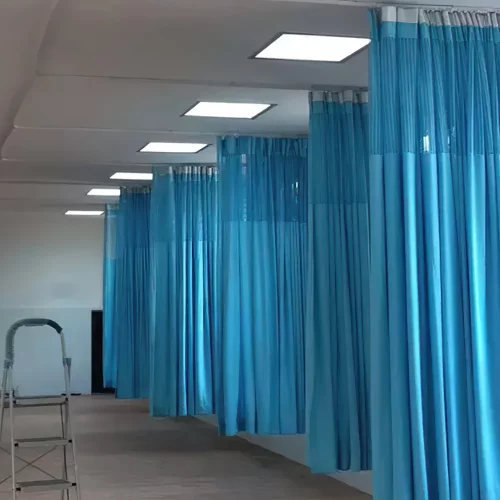دور المنسوجات المقاومة للهب في تعزيز السلامة في مكان العمل

تعريف المنسوجات المقاومة للهب
المنسوجات المقاومة للهب هي الأقمشة المعالجة أو تلك المصنوعة من ألياف مقاومة للهب بشكل طبيعي. على مدار تطورها، أصبحت المنسوجات المقاومة للهب لا غنى عنها في معظم الصناعات وأتاحت إحياء لوائح السلامة من الحرائق الإلزامية اليوم. علاوة على ذلك، مع تطور تكنولوجيا تطوير المنسوجات يومًا بعد يوم، أصبح هذا النوع من الأقمشة أكثر فعالية وراحة وملاءمة لأي مجموعة متنوعة من ظروف العمل.
بيئات العمل التي تستفيد من المنسوجات المقاومة للهب
إن تطبيقات المنسوجات المقاومة للهب واسعة النطاق في العديد من أماكن العمل، خاصة تلك التي تتعامل مع درجات الحرارة المرتفعة أو اللهب أو المخاطر الكهربائية. التصنيع والبناء والمرافق هي أمثلة رئيسية للصناعات التي تكون فيها هذه الملابس مفيدة للغاية لسلامة العمال. سواء أكان الأمر يتعلق باللحام وأشغال المعادن، أو الصيانة الكهربائية ذات الجهد العالي أو غيرها من المهن التي قد تنطوي على مواد قابلة للاشتعال، فإن الملابس الواقية التي تعتمد على المنسوجات ذات خصائص مقاومة اللهب ضرورية لتقليل مخاطر الإصابات. أكثر من مجرد ضمان سلامة العمال، فإن استخدام الحلول في هذا المجال يساهم في إنشاء ثقافة واعية بالسلامة في المنظمة.
آليات العمل في المنسوجات المقاومة للهب
قدرات الإطفاء الذاتي
تم تصميم المنسوجات المقاومة للهب بقدرات على الخروج الذاتي، وفي معظم الحالات، ستحاول الإطفاء سريعًا عند مواجهة اللهب. إنها تشكل عنصرًا أساسيًا أثناء حوادث الحريق ويمكن أن تكون بمثابة حاجز حيوي، مما يحد من الضرر المحتمل الذي قد يتعرض له مرتديها بسبب الحروق الشديدة. ولذلك فإن معدل الإطفاء الذاتي مقبول من خلال طرق الاختبار مثل ASTM F1506. يحدد هذا الاختبار الحد الأدنى من المتطلبات التي يجب أن تستوفيها المواد لاستخدامها في حماية الأجزاء السفلية والعلوية من الجسم من التعرض للهب.
تقليل تراكم الحرارة
بصرف النظر عن قدرتها على الإطفاء من تلقاء نفسها، تجدر الإشارة أيضًا إلى أن المنسوجات المقاومة للهب تقلل من تراكم الحرارة عند تعرضها لدرجات حرارة عالية بشكل كبير. من المهم حماية العمال والتأكد من حمايتهم في حالة وجود مخاطر كبيرة. عندما يتم تخفيف تراكم الحرارة، يتم تحقيق هامش أكبر من السلامة، مما يعني أن العمال لديهم المزيد من الوقت للرد على المواقف الخطرة. أخيرًا,telالقدرة على البقاء مستقرًا حرارياً على تحسين سلامة مكان العمل, مما يعني أن العمال يتمتعون بحماية أفضل.
المتانة والمرونة
يتم تحديد فعالية المنسوجات المقاومة للهب في البيئات عالية الضغط من خلال متانتها ومرونتها. تم تصميم هذه المواد للاستخدام في البيئات الصناعية، بحيث يمكن ارتداؤها وغسلها بشكل متكرر. إن ارتداء الملابس المقاومة للهب والمصنوعة من القماش يضمن بقاء معدات الحماية لفترة طويلة، كما يضمن حصول الموظفين على الحماية والقيمة المطلوبة بمرور الوقت. إن استخدام المنسوجات التي تم اختبارها بدقة، كما هو مذكور في المعايير والمتطلبات الدولية مثل NFPA 701، يضمن أنها لن تتحلل طوال دورة حياتها.
تطبيقات مقاوم للحريق (متأصل مثبطات اللهب) الأقمشة
نظرة عامة على الأقمشة مقاوم للحريق
متأصل مقاوم للهب( مقاوم للحريق ) الأقمشة مقاومة للحريق داخل الألياف غير المعالجة في الأعلى. يتم الاحتفاظ بخصائص FR طوال مدة النسيج مع الاحتفاظ بالميزات من خلال الغسيل أو التآكل. تم تصميم هذه الأقمشة لتلبية المعايير العالية، وبالتالي، يتم اختبارها بعدة طرق مثل ISO 6941:2003 وBS 6249. تُستخدم أقمشة IF في العديد من التطبيقات المتخصصة المتنوعة في مختلف القطاعات.
الفوائد في بيئات التصنيع
في أماكن التصنيع، يمكن أن يكون تأثير الأقمشة مقاوم للحريق كبيرًا جدًا من حيث سلامة العمال. المنشآت الصناعية معرضة لمخاطر متعددة، بما في ذلك التعاون مع اللهب الناتج عن اللحام أو العمليات الأخرى التي تولد حرارة شديدة. الملابس المصنوعة من مواد مقاوم للحريق لا تشكل طبقة واقية على السطح فحسب، بل تعمل أيضًا كدرع ثانوي ضد المخاطر الحرارية. مع الاستمرار وعاجِز صetardant جكره المقدمة من BEGOODTEX، يكون العمال أقل عرضة للإصابة بإصابات خطيرة عند ملامستهم للهب عن طريق الخطأ، مما يؤدي إلى تحسين الجو ورفع الروح المعنوية في مكان العمل بشكل عام.

استخدامها في ملابس المستشفى
نظرًا لمتطلبات الأجهزة الإلكترونية الطبية وسيناريوهات العمل الخاصة، فإن بيئة العمل في المستشفى لديها متطلبات صارمة للوقاية من الحرائق، لذلك مقاوم للحريق قماش الأقمشة الطبية ضرورية جداً. يعد استخدام الأقمشة مقاوم للحريق لملابس المستشفيات أمرًا مفيدًا، لأنه ليس فقط الموظفين محميين، ولكن أيضًا المرضى والمبنى في المناطق الحساسة آمنون أيضًا. علاوة على ذلك، تمتلك الإمدادات الطبية BEGOODTEX أيضًا وظيفة مقاومة للماء، مما يمنع بشكل فعال اختراق السائل إلى ملاءات السرير والستائر وملابس العمل. لا تحافظ هذه الطبقة المقاومة للماء على جفاف المنتجات ونظافتها فحسب، بل تمنع أيضًا تسرب السائل إلى المراتب والفراش، مما يضمن بيئة أكثر نظافة وصحة.
معدات الحماية للعاملين في المرافق
تمثل ظروف العديد من مهام عمال المرافق مستويات عالية من المخاطر بطبيعتها، وغالبًا ما تتطلب من هؤلاء الموظفين العمل في الأنظمة الكهربائية أو حولها أو التعرض لخطر الحرائق المفاجئة. وبالتالي، من الضروري استخدام معدات إضافية لعمال المرافق الذين تم تصنيعهم باستخدام منسوجات مقاومة للهب. تم تصميم ملابس العمل التي تم تطويرها من هذه المواد لتحمل متطلبات العمل في الهواء الطلق وتوفير درجة من الحماية عند حدوث وميض قوس كهربائي أو أي موقف خطير آخر. تعتبر الملابس الواقية المصنوعة من المنسوجات المقاومة للهب مبادرة مهمة تتعلق بالصحة والسلامة لأي شركة مرافق.
مزايا تنفيذ المنسوجات المقاومة للهب
تعزيز سلامة الموظفين والأداء
في الصناعات التي تواجه مخاطر الحرائق بانتظام، يبدو أن استخدام المنسوجات المقاومة للهب في مكان العمل له تأثير واضح على سلامة الموظفين. ينخفض خطر الإصابة بالحروق بسبب الخصائص الوقائية لـ FRT، مما يؤدي إلى قدرة الموظفين على التركيز على عملهم دون القلق بشأن الجروح المحتملة المرتبطة بالحريق. عندما يتم حماية العمال من أي إصابات، فإنهم يميلون إلى الأداء بشكل أفضل، مع التركيز على المهمة التي يقومون بها دون خوف على صحتهم وحياتهم. علاوة على ذلك، ونظراً لانخفاض عدد الحوادث المرتبطة بالعمل، فربما تكون الشركات قد خفضت مسؤوليتها، ونتيجة لذلك، انخفضت أسعار التأمين على المدى الطويل.
حماية المواد والمعدات الحديثة
مقدمة يتسبب احتراق المواد في خسارة إضافية طويلة المدى للشعلة البشرية للموظفين والمعدات الحديثة في مختلف الصناعات. من الواضح أن عددًا كبيرًا من الأدوات والمواد الخام مهددة بمخاطر الحرائق التي يمكن أن تكون سببًا لتدهور لا يمكن إصلاحه، مما يتطلب توقفًا طويلًا في الاستخدام، أو تجديد باهظ الثمن، أو استبدال كامل. في هذا الصدد، كجزء من ملابس العمل، يمكن أن تصبح المنسوجات المثبطة وسيلة فعالة لتصنيع المنتجات لحماية استثمار المنظمة. يمكن أن يساعد استخدام المعدات المقاومة للحريق في منع اشتعال الأدوات والوحدات، وإطالة عمر المرافق والقدرات التشغيلية.
اعتبارات عند اختيار حلول المنسوجات المقاومة للهب
معايير الامتثال
ترتبط السلامة في مكان العمل ارتباطًا وثيقًا بالاختيار الصحيح لحلول المنسوجات المقاومة للهب، وبالتالي الامتثال للمعايير المعمول بها. تم وضع معايير صناعية مختلفة للتأكد من أن معدات الحماية تلبي شروطًا محددة وتوفر السلامة الكافية. على سبيل المثال، وفقًا لمعيار NFPA 701:2019، يجب تقييم المواد النسيجية للتحقق من خصائص الحرق المحددة. بالإضافة إلى ذلك، يمكن استخدام معيار ASTM F1506 لشراء الملابس المصممة خصيصًا للعاملين في مجال الكهرباء واللحام.
المخاطر البيئية المحددة
هناك جانب خاص آخر يجب مراعاته عند اتخاذ قرار بشأن حل المنسوجات المثبطة للهب لمكان العمل المعني ويتعلق بنوع البيئة والمخاطر الموجودة هناك. وفي الواقع، يجب أن تتوافق المواد المقدمة مع طبيعة العمل والمخاطر التي تهدد صحة الموظفين. على سبيل المثال، في الحالات التي تتعامل مع الأقواس الكهربائية في بعض الصناعات، ينبغي اعتبار المواد التي تتوافق مع معايير الأداء ذات التصنيف القوسي، مثل ASTM F1506، ذات أولوية. ونتيجة لذلك، فإن معدات الحماية المصممة لهذه الحالة لن تخفف من حدوث إصابات الحروق في هذه الحالات فحسب، بل ستوفر أيضًا للموظفين أفضل دفاع ممكن.
وفي الختام، فإن تلك الشركات التي ترغب في تنفيذ المنسوجات المثبطة للهب سوف تحتاج إلى الانخراط في إجراءات سلامة جديدة وأكثر قوة من جانب جميع المعنيين. يتضمن هذا إلى حد كبير وضع احتياجات الموظفين في المقدمة، والتأثير على اختيار المنسوجات المناسبة المقاومة للهب والتي من شأنها تقليل المخاطر، وحماية المعدات والعتاد، والامتثال لمعايير إدارة السلامة والصحة المهنية والقوانين ذات الصلة، وإبطال أنواع مختلفة من المخاطر التي قد تنجم عن العمليات وتحسين هذه الظروف. باختصار، المنسوجات المقاومة للهب لا تتعلق فقط بالامتثال ولكنها شهادة على صحة وسلامة أولئك الذين تتمثل مهمتهم في تنفيذ المنسوجات المذكورة.
